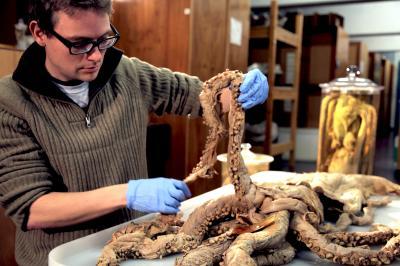The giant squid is extremely rarely seen but remains are found in the formalin or ethanol collections of various museums.
An international team has learned that no matter where in the world they are found, giant squid are so closely related at the genetic level that they represent a single, global population - despite previous statements, they are a single species worldwide. In 1857 the Danish naturalist Japetus Steenstrup determined that this beast was the same animal that gave rise to centuries of sailors' tales about monsters in the deep, later immortalized by writers such as Jules Verne and Herman Melville. He gave it the name Architeuthis dux.
Less than year ago, Architeuthis dux was first filmed alive in its natural element. The footage was taken by a small submarine lying off the Japanese island of Chichi Jima at a depth of 630 meters using 100 missions and 400 hours of filming.
Ph.D. student Inger Winkelmann and her supervisor Professor Tom Gilbert, from the Basic Research Centre in GeoGenetics at the Natural History Museum of Denmark, Copenhagen University, have managed to place new bricks into the puzzle of this giant 10 armed invertebrate, that is credibly believed to grow up to 13 meters long and over 900 kilograms in weight. Their conclusion: No matter what a sample looks like, its one species all over the deep oceans of the planet.

DNA-researchers at the University of Cophagen have found out that the giant squid is the same species all over the deep oceans of the planet. Credit: Anders Drud and Frederik Wolff Teglhus, University of Copenhagen, Denmark
"We have analysed DNA from the remains of 43 giant squid collected from all over the world. The results show, that the animal is genetically nearly identical all over the planet, and shows no evidence of living in geographically structured populations. We suggest that one possible explanation for this is that although evidence suggests the adults remain in relatively restricted geographic regions, the young that live on the ocean's surfaces must drift in the currents globally. Once they reach a large enough size to survive the depths, we believe they dive to the nearest suitable deep waters, and there the cycle begins again," says Winkelmann. "Nevertheless, we still lack a huge amount of knowledge about these creatures. How big a range to they really inhabit as adults? Have they in the past been threatened by things such as climate change, and the populations of their natural enemies, such as the planet's largest toothed whale, the sperm whale that can grow up to 20 m in length and 50 tons? And at an even more basic level…how old do they even get and how quickly do they grow?"
The kraken and the seamonk
These new results about the mysterious giant squid fall on the 200th anniversary of Danish naturalist and polymath Japetus Steenstrup (born in 1813). At the age of 44, in 1857, Steenstrup saw that many of the monsters of sea-legend were related to fragments that he had been sent of what appeared to be a giant squid, and in doing so described the species for the first time and removed any hope that sea monsters such as the Kraken and sea-monk really existed.
Professor Tom Gilbert, who lead the team that undertook the research, says, "It has been tremendous to apply the latest techniques in genetic and computational analyses, to follow up on Steenstrup's scientific research 146 years after he started it. But its also been a fantastic experience to work with the giant squid as a species, because of its legendary status as a seamonster. But despite our findings, I have no doubt that these myths and legends will continue get today's children to open their eyes up - so they will be just as big as the real giant squid is equipped with to navigate the depths."
Published in the Proceedings of the Royal Society B.





Comments